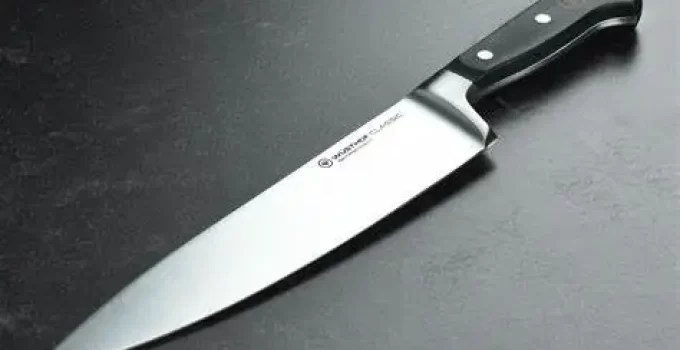Iron Chef was my first experience. At 8 years old, I was astonished by the chefs’ fast knife skills and their familiarity with unfamiliar ingredients. I was curious how they managed to choose among all these types of kitchen knives.
Fast forward 20 years, and I have been working in American kitchens for almost two decades. This was a result of my fascination with Iron Chef. I have had the opportunity to use almost every knife that you could find in a professional or home kitchen.
This guide will share my knowledge and experiences with you.
I will be discussing the different types of kitchen knives, their defining characteristics and what you should look out for when choosing one for your kitchen.
- Chef’s Knife
The chef’s knife is the most emblematic knife for professional chefs. Also known as a French knife or cook’s knife, it’s also known as the French knife. These large, heavy knives measure between 6-12 inches in length and can be used for everything, from cutting through chicken bones to slicing up large chunks of beef to mincing and slicing vegetables.
Chef’s knives blades can be either made by hand or stamped using a die-cutting machine. Because they can be sharpened and are more durable, forged blades are the best.
- Paring Knife
Paring knives were traditionally used in French kitchens as a partner with the chef’s knife. They are designed for delicate and intricate work. You can use them to peel fruits or devein hot peppers. Just make sure you wash your hands well afterward.
Paring knives are 2 1/2 inches to 4 inches in length and very lightweight. These Cooking food knives kitchen are also a great addition to your kitchen knife collection. They can be used for cutting fruit pieces or topping a salad with, and they’re very affordable.
- Santoku Knife
The Japanese chef’s knife, the santoku, is the most popular of all Japanese kitchen knives. They measure 6 to 7 inches in length, which is slightly shorter than the chef’s knife. However, their super-hardened steel knives make them ideal for any kitchen purpose and can hold an edge for longer than their Western counterparts.
Although the knives have similar uses, their handling will differ due to the differences in the handle design, curvature and blade angle. Santoku knives work best when you cut straight through meat and produce.
We could go on and on about the santoku knives as well as Japanese knives in general. But will have to wait for another article.
- Utility Knife
The utility knife is a great kitchen tool. It can do everything and is a favourite of minimalist home chefs. They measure between a paring knife or a chef’s knives and can be found in sizes ranging from 4 to 7 inches.
A utility knife is a jack-of-all trades. However, it can also be a master of none. They aren’t as powerful as the heavier, larger chef’s knives and can’t do delicate tasks as a paring or chopping knife.
A quality knife such as the J.A. Classic 6-inch utility knife is still a good choice. Henckels are a great starting knife for home cooks, as they can practice their knife skills without needing to select the right blade.
- Bread Knife
Are you a bread-baker? Yes, I have. I was too hungry for fresh, baked bread to be satisfied by store-bought loaves. While my first loaves were not spectacular, I realized that a good bread knife was essential to keep fluffy loaves looking fantastic after each slice.
The bread knife measures between 6-10 inches in length. It is perfect for cutting bread without having to crush it. It is difficult to sharpen due to its serrated edges. However, even a cheap knife such as the OXOGood Grips bread knife can keep an edge for up 1 year if it’s used only to cut bread.
- Butter Knife
The butter knife is a great kitchen tool, even though it is often placed alongside forks and spoons at the table. They are not well-suited for preparing fruits or vegetables, but they can be used to spread butter, jam or preserves on freshly baked rolls.
- Cleaver
The cleaver, which is large, rectangular and heavy, is the preferred tool for cutting meat. It is specifically designed to cut through bone. The thick blade makes it easier for chefs to “drop” their blades, making stronger cuts more comfortable.
Cleavers can have different degrees of curvature depending on where they were made. While Chinese-style cleavers have a straight blade, German cleavers tend to have a more exaggerated curve. The straight Chinese-style cleaver blade is my favorite for its balance. However, I know some chefs who prefer a curved blade to allow them to rock smaller chicken bones.
- Carving knife
Carving knives, which are longer than a chef’s knife and have a thinner blade, are a staple at Thanksgiving. These knives can be used to cut thin slices of meat from large roasts such as turkey, ham, or the like.
These knives have thinner blades than a chef’s knife. Their length (8-12 inches) and flexibility allow for precise cuts. This knife is rarely used in my kitchen to cut roasts, but it is the best.
- Slicing Knife
The slicing knives are similar to carving knives, but longer and thinner. It is easily identifiable by its blunt tip. They can be found with a serrated or plain edge. However, I prefer plain edges for larger cuts in large roasts and fish.
The second-most flexible type of kitchen knife is the slicing knife. They are a great alternative to the carving knife that I use often interchangeably with my slicer.
- Boning Knife
A Boning knife measures 5 to 6 inches in length and has the longest blade of any kitchen knife. It is designed for one purpose: To remove the bones from meat, poultry and fish.
A boning knife is a great tool for meal prep if you buy bone-in meats or whole chickens regularly.
The cost of a boning knife is not prohibitive. They are also much cheaper than the hand-forged, more expensive blades. Victorinox’s Swiss Army boning knives are a great example. They also come with a non-slip grip.
- Filet Knife
Filet knives, another member of the boning knife clan, are the best choice for cutting fish. They have long, thin (6 to 11 inches) and flexible blades that can slide under skin and separate flesh from fish.
A fillet knife’s pointed blade transitions into a sharp curve, which allows for easy entry to the skin of fish and smooth cuts throughout the meat’s length. Stainless steel is the preferred metal for filet knives. It provides corrosion resistance which is important in the wet environments where these knives are used.
- Nakiri
The Japanese Nakiri Bocho is the best Western knife. It’s a knife that is specifically designed for cutting vegetables.
Nakiri knives have thin, lightweight blades that are perfectly straight. This allows you to cut straight into vegetables without having to pull or push. This can be difficult to see, so watch this video to see the precision cutting capabilities of the Nakiri.
- Mezzaluna
It is the Italian specialty “half-moon knife”, The mezzaluna. Its name comes from the curving shape of its blade. Instead of cutting and dicing in one direction, the mezzaluna can be rocked backwards over your ingredients, chopping, and mincing with minimal effort.
The mezzaluna was created because of the high amount of minced herbs, and garlic found in Italian cooking. This blade is great for cutting fresh herbs and garlic, pesto and sauces.
- Steak Knife
Modern place settings will only have one sharp knife: the steak knife. It is used to cut — yes, you guessed it — steak. They are usually 4 inches in length, made from stainless steel and can be either straight or serrated.
A good set of steak knives is essential for a great backyard barbecue. There are many options for steak knives, but I prefer the classic wooden handles like Cuisinart’s walnut Steak knives.
- Cheese knives
Due to the variety of textures found in fine cheeses you will find many different types of knives to help cut them. Three types stand out in particular:
- Soft cheese knives have holes at the center of the blade to prevent soft cheeses sticking to the blade while cutting.
- The hard cheese knife has a forked tip to spear cheese pieces and a rigid, sharp blade that allows you to cut through denser types of cheese.
- Parmesan knives can be used to cut through hard cheeses. They look like a garden trowel, but have a sharp edge. They are not meant to cut through the cheese. Instead, they should be inserted and pulled back, separating pieces of parmesan one at a time.
While it is not a knife but a wire cutter, it is worth mentioning that they are also a popular choice for cutting cheese.
- Kitchen Shears
Is there anything better than one kitchen knife! Two kitchen knives connected with a handle? That’s the simplest definition of kitchen shears. They’re a great addition to any kitchen.
Kitchen shears are great for cutting herbs and salad leaves. They can also be used to quickly cut portions of chicken breasts for salads while you open the plastic wrapper. Make sure you get a pair kitchen shears with a handle that can be separated, such as OXO’s Good Grips Kitchen shears. This makes them easier to clean and more sanitary.
Wrapping up: Essential Kitchen Knives
You’re now familiar with the various types of knives available and how they are used. Now you might be asking: How many do I actually need?
A simple set of knives that includes a paring and sharp chef’s knife is ideal for home cooking. A serrated bread knife is a great addition to any collection if you are a regular sourdough slicer.
You can explore new types and materials of knives as you improve your cooking skills. You can’t stop your kitchen with just a few knives and essential cookingware.
This guide is a deeper dive into the topic that I wrote recently. It will tell you about the five essential knives that I believe are important and why they deserve a place in your kitchen.



